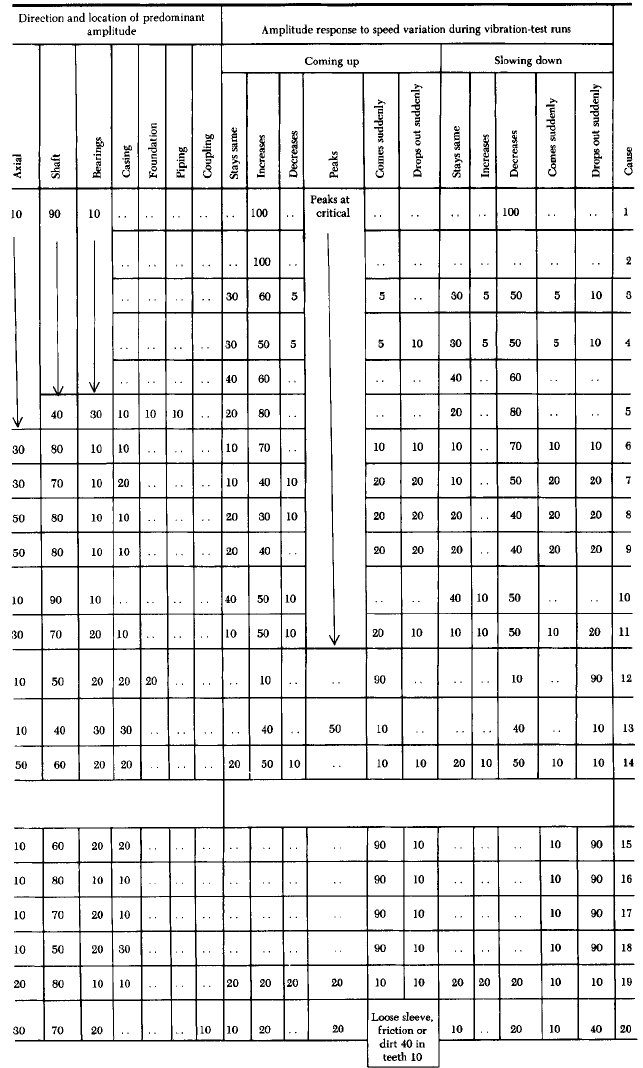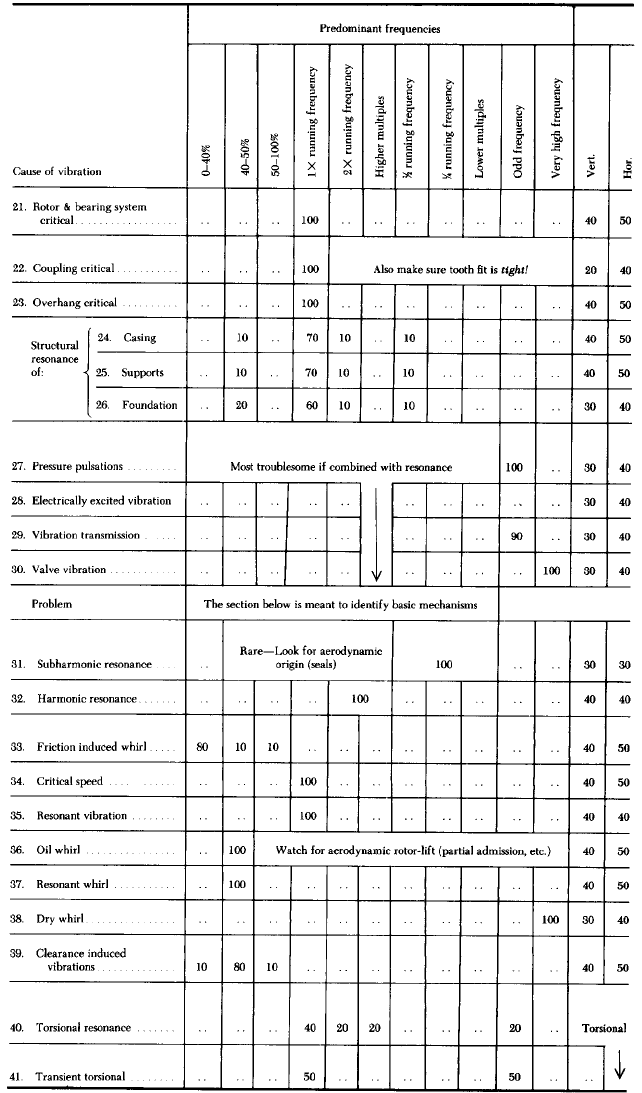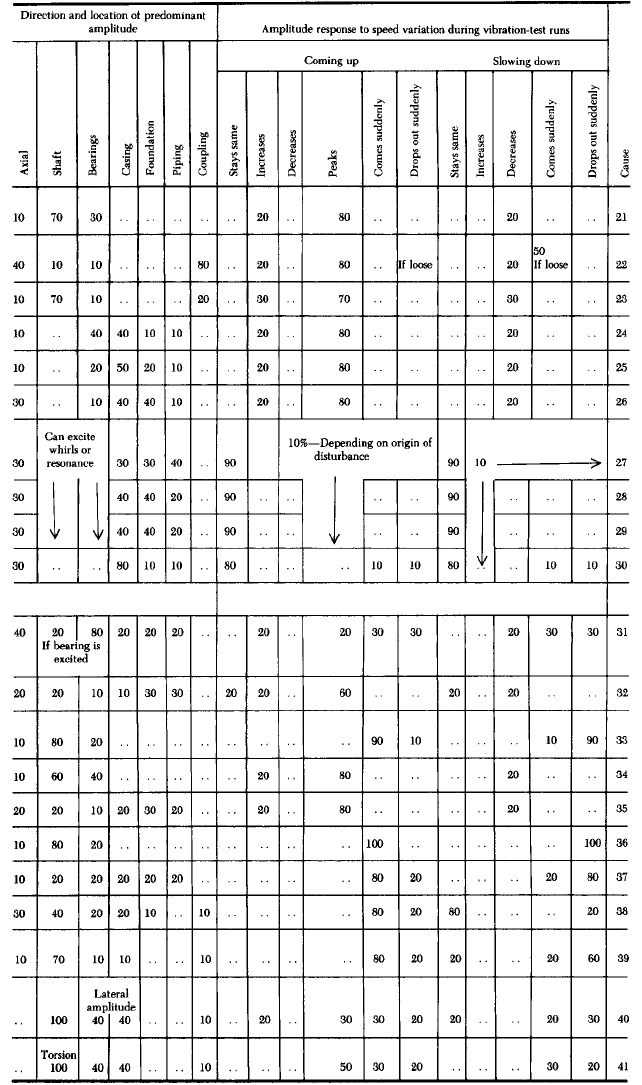Pump Handbook by Igor J. Karassik, Joseph P. Messina, Paul Cooper, Charles C. Heald - 3rd edition
Подождите немного. Документ загружается.


TABLE 2 Vibration analysis symptoms
Numbers indicate percent of cases showing previous symptoms, for causes listed in vertical column at left.
Source: The Practical Vibration Primer by Charles Jackson. Copyright (c) 1979 by Gulf Publishing Company,
Houston, Texas. Used with permission. All rights reserved.

2.427
TABLE 2 Continued.

2.428
TABLE 2 Continued.

2.429
TABLE 2 Continued.

2.430 CHAPTER TWO
TABLE 3 Bearing cap data-velocity unfiltered
Planned
shutdown for Immediate
Smooth Acceptable Marginal repairs shutdown
0.1 in/s (p) and less 0.1
—
0.2 in/s (p) 0.2
—
0.3 in/s (p) 0.3
—
0.5 in/s (p) 0.5 in/s (p)
Note: For gearing, add 0.1 in/s to all values.
p peak
mm/s 25.4 in/s
2. Bent rotors can sometimes be straightened by the “hot-spot” procedure, but this
should be regarded as a temporary solution because bow will come back in time. Sev-
eral rotor failures have resulted from this practice. If blades or disks have failed, check
for corrosion fatigue, stress corrosion, resonance, off-design operation.
3. Straighten bow slowly, running on turning gear or at low speed. If rubbing occurs, trip
unit immediately and keep the rotor turning 90° using a shaft wrench every 5 minutes
until the rub clears; resume slow run. This may take 12 to 24 h.
4. Often requires complete rework or new case, but sometimes a mild distortion corrects
itself with time (requires periodic internal and external realignment). Usually caused
by excessive piping forces or thermal shock.
5. Usually caused by poor mat under the foundation or thermal stress (hot spots) or
unequal shrinkage. May require extensive and costly repairs.
6. Slight rub may clear, but trip the unit immediately if a high-speed rub gets worse.
Turn by hand until clear.
7. Unless thrust bearing has failed, this is caused by rapid changes of load and temper-
ature. Machine should be opened and inspected.
8. Usually caused by excessive pipe strain or inadequate mounting and foundation,
but is sometimes caused by local heat from pipes or the sun’s heating the base and
foundation.
9. Most trouble is caused by poor pipe supports (should use spring hangers), improperly
used expansion joints, and poor pipe line up at casing connections. Foundation setting
can also cause severe strain.
10. Bearings may become distorted from heat. Make a hot check, if possible, observing
contact.
11. Watch for brown discoloration, which often precedes recurring failures. This indicates
very high local oil film temperatures. Check rotor for vibration. Check bearing design
and hot clearances. Check condition of oil, especially viscosity.
12. Check clearances and roundness of journal, as well as contact and tight bearing fit in
the case. Watch out for vibration transmission from other sources and check the fre-
quency. May require antiwhirl bearings or tilting-shoe bearings. Check especially for
resonances at whirl frequency (or multiples) in foundation and piping.
13. This can excite resonances and criticals and combinations thereof at two times run-
ning frequency. Usually difficult to field balance because, when horizontal vibration
improves, vertical vibration gets worse and vice versa. It may be necessary to increase
horizontal bearing support stiffness (or mass) if the problem is severe.
14. Usually the result of slugging the machine with fluid, solids built up on rotor, or off-
design operation (especially surging).
15. The frequency at rotor support critical is characteristic. Disks and sleeves may have
lost their interference fit by rapid temperature changes. Parts usually are not loose at
standstill.
2.3.3 CENTRIFUGAL PUMP MECHANICAL PERFORMANCE 2.431
16. It is often confused with oil whirl because the characteristics are essentially the same.
Before suspecting any whirl, make sure everything in the bearing assembly is
absolutely tight with an interference fit.
17. This should always be checked.
18. It usually involves shading pedestals and casing feet. Check for friction, proper clear-
ance, and piping strains.
19. To obtain frequencies, tape a microphone to the gear case and record noise on mag-
netic tape.
20. Loose coupling sleeves are notorious troublemakers, especially in conjunction with
long, heavy spacers. Check tooth fit by placing indicators on top, then lifting by hand
or a jack and noting looseness (should not be more than 1
—
2 mils [0.025 to 0.05 mm]
at standstill, at most). Use hollow coupling spacers. Make sure coupling hubs have at
least 1 mil/in (1 mm/m) interference fit on shaft. Loose hubs have caused many shaft
failures and serious vibration problems.
21. Try field balancing; more viscous oil (colder); larger, longer bearings with minimum
clearance and tight fit; stiffen bearing supports and other structures between bearing
and ground. This is basically a design problem. It may require additional stabilizing
bearings or a solid coupling. It is difficult to correct in the field. With high-speed
machines, adding mass at the bearing case helps considerably.
22. These are criticals of the spacer-teeth-overhang subsystem. Often encountered with
long spacers. Make sure of tight-fitting teeth with a slight interference at standstill
and make the spacer as light and stiff as possible (tubular). Consider using a solid or
membrane coupling if the problem is severe. Check coupling balance.
23. Overhang criticals can be exceedingly troublesome. Long overhangs shift the nodal
point of the rotor deflection line (free-free mode) toward the bearing, robbing the bear-
ing of its damping capability. This can make critical speeds so rough it is impossible
to pass through these speeds. Shorten the overhang or put in an outboard bearing for
stabilization.
24. Casing resonance is also called case drumming. It can be very persistent but is some-
times harmless. The danger is that parts may come loose and fall into the machine.
Also, rotor/casing interaction may be involved. Diaphragm drumming is serious
because it can cause catastrophic failure of the diaphragm.
25. Local drumming is usually harmless, but major resonances, resulting in vibration of
the entire case as a unit, are potentially dangerous because of possible rubs and com-
ponent failures, as well as possible excitation of other vibrations.
26. Similar problems exist as in 24 and 25 with the added complications of settling, crack-
ing, warping, and misalignment. This cause may also produce piping troubles and pos-
sible case warpage. Foundation resonance is serious and greatly reduces unit reliability.
27. Pressure pulsations can excite other vibrations with possible serious consequences.
Eliminate such vibrations using restraints, flexible pipe supports, sway braces, shock
absorbers, and so on, plus isolation of the foundation from piping, building, basement,
and operating floor.
28. It occurs mostly at two times line frequency (7200 cpm), coming from motor and gener-
ator fields.Turn the fields off to verify the source. It is usually harmless, but if the foun-
dation or other components (rotor critical or torsional) are resonant, the vibrations may
be severe.There is a risk of catastrophic failure if there is a short circuit or other upsets.
29. This can excite serious vibrations or cause bearing failures. Isolate the piping and
foundation and use shock absorbers and sway braces.
30. Valve vibration is rare but sometimes very violent. Such vibrations are aerodynami-
cally excited. Change the valve shape to reduce turbulence and increase rigidity in the
valve gear. Make sure the valve cannot spin.
31. The vibration is exactly one-half, one-quarter, one-eighth of the exciting frequency. It
can be excited only in nonlinear systems; therefore, look for such things as looseness

2.432 CHAPTER TWO
and aerodynamic or hydrodynamic excitations. It may involve rotor “shuttling.” If so,
check the seal system, thrust clearances, couplings, and rotor-stator clearance effects.
32. The vibrations are at two, three, and four times exciting frequency. The treatment is
the same as for direct resonance: change the frequency and add damping.
33. If the cause is intermittent, look into temperature variations. Usually the rotor must
be rebuilt, but first try to increase stator damping, add larger bearings (tilting-shoe),
increase stator mass and stiffness, and improve the foundation. This problem is usu-
ally caused by maloperation, such as quick temperature changes and fluid slugging.
Use membrane-type coupling.
34. This is basically a design problem, but is often aggravated by poor balancing and a
poor foundation. Try to field-balance the rotor at operating speed, lower oil tempera-
ture, and use larger and tighter bearings.
35. Add mass or change stiffness to shift the resonant frequency. Add damping. Reduce
excitation and improve system isolation. Reducing mass or stiffness can leave the
amplitude the same even if resonant frequency shifts because of stronger amplifica-
tion. Check “mobility.”
36. Stiffen the foundation or bearing structure. Add mass at the bearing, increase critical
speed, or use tilting-shoe bearings (which is the best solution). First, check for loose fit
of bearings in bearing case.
37. Same comments as 36 with additional resonance of rotor, stator, foundation, piping, or
external excitation; find the resonant members and the sources of excitation. Tilting-
shoe bearings are the best. Check for loose bearings.
38. Sometimes you can bear the squeal of a bearing or seal, but frequency is usually ultra-
sonic
—
very destructive. Check for rotor vanes hitting the stator, especially if clear-
ances are smaller than the oil film thickness plus rotor deflection while passing
through the critical speed.
39. Usually accompanied by rocking motions and beating within clearances. It is serious
especially in the bearing assembly. Frequencies are often below running frequency.
Make sure everything is absolutely tight, with some interference. Line-in-line fits are
usually not sufficient to positively prevent this type of problem.
40. This problem is very destructive and difficult to find. The symptoms are gear noise,
wear on the hack side of teeth, strong electrical noise or vibration, loose coupling bolts,
and fretting corrosion under the coupling bolts.There is wear on both sides of coupling
teeth and possibly torsional-fatigue cracks in keyway ends. The best solution is to
install properly tuned torsional vibration dampers.
41. It is similar to 40, but encountered only during startup and shutdown because of very
strong torsional pulsations. It occurs in reciprocating machinery and synchronous
motors. Check for torsional cracks.
Impeller Unbalance Impeller unbalance appears as a 1 running speed frequency
vibration approximately 90% of the time and may be mechanical or hydraulic in origin.
Impeller mechanical unbalance is a frequent cause of mechanical seal and bearing fail-
ures. Many mechanics will never think of checking impeller balance until heavily pitted
areas appear. Because of the nonhomogeneous nature of most castings, corrosion is usu-
ally more aggressive in one area of the impeller. The degree of etching or surface pitting
is a judgmental indicator of balance change. Impeller balancing should be part of the shop
repair procedure for impellers over 10 in (25 cm) at 3600 rpm. It is good practice, when
balancing an impeller, to keep the impeller bore to balance mandrel fit no greater than
0.001 in (0.0254 mm) loose. Installing the impeller with the keyway up on the balance
mandrel and pump shaft will help eliminate some of the unbalance due to shaft center-
line shift.
EXAMPLE A 38-lb (17.2 kg), 15 -in (39.4-cm) diameter impeller operating at 3600 rpm
is balanced on a machine good to 25 10
6
in (635 10
6
mm) using an expanding man-
1
2

2.3.3 CENTRIFUGAL PUMP MECHANICAL PERFORMANCE 2.433
drel. The impeller is then installed on its shaft, which has a loose fit of 0.0035 in (0.0889
mm). The forces created by this shift in the center of mass is calculated as follows:
in USCS units
in SI units
The example also points out that the unbalance force generated by loose fit
impellers with keyways mounted in one plane could be quite high. This force could be
minimized by staggering keyways or randomly orienting the impellers on the balance
mandrel. Shifting of shrink-fitted, well-balanced impellers on multistage and high-
speed double-suction pumps after a period of operation can result in unbalance. The
shifting of the impeller is due to the relaxation of residual stresses that built up as the
impeller cooled and contracted around the shaft. Shaft vibration and flexing tend to
relieve the residual stress and cause the impeller to cock or bow the shaft from the orig-
inal balance centerline.
Standards should be referred to for balancing pumps and their drivers. When balanc-
ing, consideration must be given to the need for balancing at rated speed in order to prop-
erly evaluate the importance of shaft deflection due to modal components of unbalance.
See References 12 and 13.
Hydraulic Unbalance Uneven flow distribution entering the impeller can cause a 1
running speed frequency type of vibration. The unbalance occurs because the flow is not
equal in all vane passages. An example of this is a double-suction impeller with a short,
straight run to the pump and an elbow in the horizontal plane. Flow from the elbow does
not have time to straighten and therefore enters both sides of the impeller unequally. A
similar condition results if suction is taken from a tee off the main header. Unequal and
unsteady flow into the impeller may cause axial thrust and high axial vibrations. Thus, it
is good design practice to install elbows vertically in double-suction pumps.
In double-suction pumps, the nonsymmetrical positioning of the impeller or the offset
of the upper case half of the lower case half will cause a 1 unbalance due to nonsym-
metrical flow.
Recirculation forces and pulsation recirculation within a pump (which can occur when
flow is less than design) may manifest themselves in the form of a noise and/or vibration
with random frequencies, along with pressure pulsation that may be seen on a pressure
gage. Recirculation may also appear in the piping system as vibration and noise. Increased
NPSHA has helped in a few cases, especially if the recirculation is mainly on the suction
side of the impeller. After a pump has a recirculation problem in a given system and the
0.01094 a
3600
1000
b
2
765 108.5 N
Unbalance force 0.01094 a
rpm
1000
b
2
unbalance 1g
#
mm2
0.0889
2
17.2 1000 765 g
#
mm
Unbalance eccentricity of impeller 1mm2 impeller wt, mass 1g2
1.77 a
3600
1000
b
2
1.064 24.4 lb
Unbalance force 1.77 a
rpm
1000
b
2
unbalance 1oz
#
in2
0.0035
2
38 16 1.064 oz
#
in
Unbalance eccentricity of impeller 1in2 impeller wt. force 1oz2

2.434 CHAPTER TWO
FIGURE 23 Relative signal strength versus days to failure for acoustic IFD and conventional vibration
monitoring methods
flow cannot be increased using a bypass, little can be done to the pump itself unless the
system characteristics allow an impeller change.
Antifriction Bearings Vibrations generated by ball bearings cover a wide range of high
frequencies that are not necessarily a multiple of the shaft running speed. The frequency
readings obtained during analysis are somewhat unsteady because of the resolution of the
filters in a hand-tuned analyzer. The amplitude reading may also be somewhat unsteady.
Experience has shown that hand-tuned field analyzers tend to show the last stage of
the bearing failure. Monitoring of stress waves or shock pulses (impact energy) on the
pump bearing housing will show failure trends that will generally precede an increase in
the detectable level of mechanical vibration. This method of failure detection is called
acoustic high-frequency monitoring or incipient-failure detection (1FD). A comparison
between conventional methods and the acoustic high-frequency method is shown in Fig-
ure 23.
Accurate analysis of pump bearings and other machinery can also be made using a
velocity sensor good to 1500 Hz or an accelerometer. Data should be recorded and
processed through a real-time analyzer with at least 256-line resolution capability and a
band selectable analysis option. Analysis of antifriction bearings using a real-time ana-
lyzer and equations for calculating frequencies generated by defective bearings can be
found in Reference 7.
Accurate and extended analysis of pump bearing vibration is generally not needed. A
majority of bearing problems are currently identified by an acoustic noise during opera-
tion. What is needed by maintenance personnel is a quick and reliable method to monitor
bearings and determine when a bearing is failing and the rate of bearing deterioration. At
present, there are some expensive instruments that can be purchased, but none of them
meet maintenance requirements.
Currently, the best method for reducing bearings analysis is prevention of the failure.
Most antifriction pump bearings fail for one of several reasons: (1) water gets into the oil,
(2) automatic oiler is not adjusted properly (this cause is most often overlooked and will
continue to produce a short life to failure cycle), (3) product gets into the oil, (4) acidic
vapors condense and break down the oil, (5) mounting techniques or fits are improper,
(6) new hearing is defective. The solution to high-humidity problems and problems with
acidic units is the use of an oil mist lubrication system. If this cannot be economically
installed, an aggressive preventative maintenance program on a monthly to every-other-
month basis is required.

2.3.3 CENTRIFUGAL PUMP MECHANICAL PERFORMANCE 2.435
Baseplates With the change from low rotating speeds and cast iron baseplates to the
less rigid fabricated steel baseplates and higher rotating speeds, higher operating tem-
peratures, and larger impellers have greatly increased the probability of baseplate vibra-
tions, distortion, and a decreased stiffness for rotor dynamics. Reference 6 has increased
coverage for piping loads and the option of a heavy-duty baseplate over the proposed stan-
dard baseplate. The reference specifies a standard baseplate and pedestal support that
are twice as rigid as specified in the fifth edition of the reference standards.
Baseplate vibration problems can be resolved at the design stage or during construc-
tion. Engineering specifications should call for leveling screws, grout filling holes [4 in
(10 cm) minimum, 6 in (15 cm) preferred for each bulkhead section], venting holes [4 in
(11 cm) holes to each bulkhead section], and corrosion protection. A check of the outline
dimension approval drawing should also be made for proper grout hole placement (bulk-
head and cross bracing must be shown on the drawing). Construction specifications should
call for proper baseplate preparation before grouting.
8
API pumps should have epoxy grout
bonding the baseplate to the concrete foundation.
After proper cure, the baseplate should be tapped for voids, especially between and
under the pump centerline supports.
EXAMPLE A high vertical vibration occurred on the coupling end bearing at vane pass-
ing frequency on a multistage volute pump. The vertical vibration was 2.5 times the
horizontal; thus, a check of the bearing pedestal and baseplate was in order. The ham-
mer test on the pan of the baseplate under the bearing pedestal showed complete lack
of grout. Vertical vibration on the pan was 1.8 times the horizontal. Regrouting elimi-
nated the pan vibration and reduced the vertical vibration to one-half of the horizon-
tal. Lack of proper stiffness from the baseplate can and will lower some pump critical
speeds into the operating range.
When a complete analysis is being done on a problem pump, take several pedestal
readings (top, middle, and bottom on the side and end) and several readings on the pan of
the baseplate. The middle, bottom, and pan readings should show good attenuation.
REFERENCES _______________________________________________________
1. IRD Mechanalysis. “Methods of Vibration Analysis.” Technical paper no. 104-1975,
IRD, Cleveland.
2. Garguilo, E. P. Jr. “A Simple Way To Estimate Bearing Stiffness.” Machine Design, July
24, 1980, p. 107.
3. Dodd, V. R. Total Alignment. Petroleum Publishing, Tulsa, 1975.
4. “Alignment Tutorium.” Proc. Tax. A&M Turbomachinery Sym., December 1980.
5. Sobre, J. S. “Operating Problems with High Speed Turbomachinery: Causes and Cor-
rections,” ASME Petroleum Mechanical Engineering Conference, Dallas, Sep. 1968.
6. American Petroleum Institute. Centrifugal Pumps for General Refinery Services. API
Standard 610, 6th ed. Washington, D.C., 1981.
7. Taylor, J. I. “An Update of Determination of Anti-Friction Bearing Condition by Spec-
tral Analysis.” Vibration Institute, Machinery Vibrations Monitoring Analysis Semi-
nar. New Orleans, April 1981.
8. Murray, M. G. Jr. “Better Pump Grouting.” Hydrocarbon Processing. February 1974.
9. Jackson, C. A Practical Vibration Primer. Gulf Publishing, Houston, 1979.
10. Mitchell, J. S. An Introduction to Machinery Analysis and Monitoring. 1st ed., Penn-
Well Books, Tulsa, 1981.
11. Messina, J. P., and S. P. D’Alessio. “Align Pump Drives Faster by Well-Planned Proce-
dure.” Power, March 1983, p. 107.
1
2
